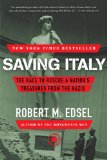Summary | Excerpt | Reviews | Beyond the Book | Readalikes | Genres & Themes | Author Bio

The Race to Rescue a Nation's Treasures from the Nazis
by Robert M. EdselPRELUDE
AUGUST 16, 1943
Padre Acerbi, a veteran of the Great War, passed another humid night in a Milan air-raid shelter with his Dominican brothers. He hoped the terrifying events of previous evenings would not be repeated. It was Sunday, August 15, 1943. That day he and his fellow citizens had held celebrations for the Feast of the Assumption of the Virgin Mary, Ferragosto, one of Italy's most important national holidays. But the festivities had been muted. Acerbi prayed for a halt in the attacks, even if just for a few hours. The weary citizens of Milan needed sleep; so did his fellow monks.
At half past midnight, as the full moon began emerging from a partial lunar eclipse, the dreaded but familiar drone of the air-raid sirens began again. Previous raids had already caused hundreds of thousands of Milanese to evacuate. Twenty minutes after the sounding of sirens, they heard the airplanes overhead, then the muffled thunder of the first bombs. The ground tremored beneath them, louder and more violent as the initial wave of Royal Air Force Lancasters approached the city center. Flashes in the distance made the luminescent sky even brighter. Fires charged the air with an acrid odor. A single four-thousand-pound bomb detonated near Acerbi's shelter with a deafening explosion.
Several nights earlier, bombs hit the Church of Santa Maria delle Grazie and its Refectory. Surprisingly, none had damaged the jewel of Milan, the dining companion of the Dominican friars: Leonardo da Vinci's The Last Supper. It had been a centuries-old tradition that the friars would share their meals in front of the north wall on which Leonardo had painted the twelve apostles preparing to eat theirs. But as dawn emerged, Padre Acerbi could see that the explosion had suspended that tradition, perhaps forever.
Leonardo took a contemplative and deliberate approach to the painting of The Last Supper. Matteo Bandello, a young monk who later became a famous writer of novellas, observed Leonardo "go early in the morning to work on the platform before The Last Supper; and there he would stay from sunrise till darkness, never laying down the brush, but continuing to paint without eating or drinking. Then three or four days would pass without his touching the work, yet each day he would spend several hours examining it and criticising the figures to himself."
Upon its completion in 1498, viewers were astonished. The standard depiction of the subject, from the catacomb paintings in the fifth and sixth century through more recent works by Taddeo Gaddi (c. 1350), Andrea del Castagno (c. 1447), Domenico Ghirlandaio (c. 1480), and Pietro Perugino (c. 1493) had emphasized the story of the Eucharist. These and other artists typically placed the twelve apostles at the dining table as Christ prepared the offering of consecrated bread and wine. The setting of each work depicted figures that were static, void of emotion. Judas often had been placed alone, across the table from Jesus and his followers.
But Leonardo, a keen observer of nature with a physician's understanding of the human body, broke with tradition by fusing the ceremony of the Eucharist with the dramatic moment when Christ announced to those gathered: "Verily I say unto you, that one of you shall betray me." Having once noted, "the movement of men are as varied as are the emotions which pass through their minds," Leonardo thus portrayed the reaction of each apostle to this shocking news. Philip sorrowfully places his hands on his chest in a plea of innocence. James the Greater gestures wildly with indignation. Bartholomew, with his eyes fixed on Christ, leans forward with his weight on the end of the table, while the shadowy figure of Judas, having knocked over the salt, recoils defensively, clutching a small bag, perhaps of silver. The master's use of color, and the lifelike appearances of the apostles, engaged the viewer as a participant in Leonardo's dramatic storytelling. Now it appeared the painting might never be seen again.
Excerpted from Saving Italy: The Race to Rescue a Nation's Treasures from the Nazis by Robert M. Edsel. Copyright © 2013 by Robert M. Edsel. With permission of the publisher, W.W. Norton & Company, Inc.






Your guide toexceptional books
BookBrowse seeks out and recommends the best in contemporary fiction and nonfiction—books that not only engage and entertain but also deepen our understanding of ourselves and the world around us.